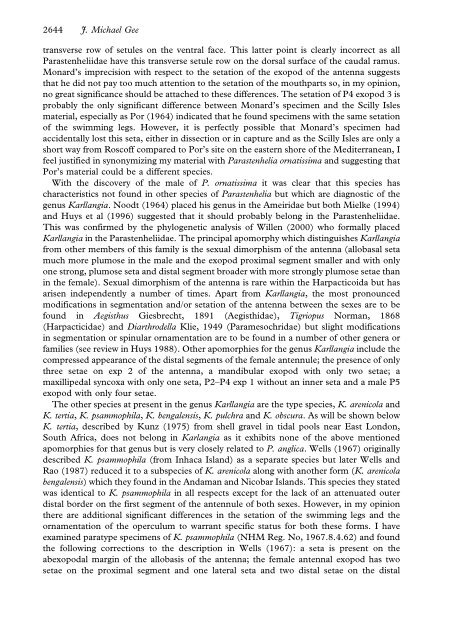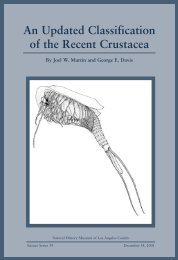Parastenheliidae (Copepoda: Harpacticoida) from ... - Luciopesce.net
Parastenheliidae (Copepoda: Harpacticoida) from ... - Luciopesce.net
Parastenheliidae (Copepoda: Harpacticoida) from ... - Luciopesce.net
Create successful ePaper yourself
Turn your PDF publications into a flip-book with our unique Google optimized e-Paper software.
2644 J. Michael Gee<br />
transverse row of setules on the ventral face. This latter point is clearly incorrect as all<br />
<strong>Parastenheliidae</strong> have this transverse setule row on the dorsal surface of the caudal ramus.<br />
Monard’s imprecision with respect to the setation of the exopod of the antenna suggests<br />
that he did not pay too much attention to the setation of the mouthparts so, in my opinion,<br />
no great significance should be attached to these differences. The setation of P4 exopod 3 is<br />
probably the only significant difference between Monard’s specimen and the Scilly Isles<br />
material, especially as Por (1964) indicated that he found specimens with the same setation<br />
of the swimming legs. However, it is perfectly possible that Monard’s specimen had<br />
accidentally lost this seta, either in dissection or in capture and as the Scilly Isles are only a<br />
short way <strong>from</strong> Roscoff compared to Por’s site on the eastern shore of the Mediterranean, I<br />
feel justified in synonymizing my material with Parastenhelia ornatissima and suggesting that<br />
Por’s material could be a different species.<br />
With the discovery of the male of P. ornatissima it was clear that this species has<br />
characteristics not found in other species of Parastenhelia but which are diagnostic of the<br />
genus Karllangia. Noodt (1964) placed his genus in the Ameiridae but both Mielke (1994)<br />
and Huys et al (1996) suggested that it should probably belong in the <strong>Parastenheliidae</strong>.<br />
This was confirmed by the phyloge<strong>net</strong>ic analysis of Willen (2000) who formally placed<br />
Karllangia in the <strong>Parastenheliidae</strong>. The principal apomorphy which distinguishes Karllangia<br />
<strong>from</strong> other members of this family is the sexual dimorphism of the antenna (allobasal seta<br />
much more plumose in the male and the exopod proximal segment smaller and with only<br />
one strong, plumose seta and distal segment broader with more strongly plumose setae than<br />
in the female). Sexual dimorphism of the antenna is rare within the <strong>Harpacticoida</strong> but has<br />
arisen independently a number of times. Apart <strong>from</strong> Karllangia, the most pronounced<br />
modifications in segmentation and/or setation of the antenna between the sexes are to be<br />
found in Aegisthus Giesbrecht, 1891 (Aegisthidae), Tigriopus Norman, 1868<br />
(Harpacticidae) and Diarthrodella Klie, 1949 (Paramesochridae) but slight modifications<br />
in segmentation or spinular ornamentation are to be found in a number of other genera or<br />
families (see review in Huys 1988). Other apomorphies for the genus Karllangia include the<br />
compressed appearance of the distal segments of the female antennule; the presence of only<br />
three setae on exp 2 of the antenna, a mandibular exopod with only two setae; a<br />
maxillipedal syncoxa with only one seta, P2–P4 exp 1 without an inner seta and a male P5<br />
exopod with only four setae.<br />
The other species at present in the genus Karllangia are the type species, K. arenicola and<br />
K. tertia, K. psammophila, K. bengalensis, K. pulchra and K. obscura. As will be shown below<br />
K. tertia, described by Kunz (1975) <strong>from</strong> shell gravel in tidal pools near East London,<br />
South Africa, does not belong in Karlangia as it exhibits none of the above mentioned<br />
apomorphies for that genus but is very closely related to P. anglica. Wells (1967) originally<br />
described K. psammophila (<strong>from</strong> Inhaca Island) as a separate species but later Wells and<br />
Rao (1987) reduced it to a subspecies of K. arenicola along with another form (K. arenicola<br />
bengalensis) which they found in the Andaman and Nicobar Islands. This species they stated<br />
was identical to K. psammophila in all respects except for the lack of an attenuated outer<br />
distal border on the first segment of the antennule of both sexes. However, in my opinion<br />
there are additional significant differences in the setation of the swimming legs and the<br />
ornamentation of the operculum to warrant specific status for both these forms. I have<br />
examined paratype specimens of K. psammophila (NHM Reg. No, 1967.8.4.62) and found<br />
the following corrections to the description in Wells (1967): a seta is present on the<br />
abexopodal margin of the allobasis of the antenna; the female antennal exopod has two<br />
setae on the proximal segment and one lateral seta and two distal setae on the distal











